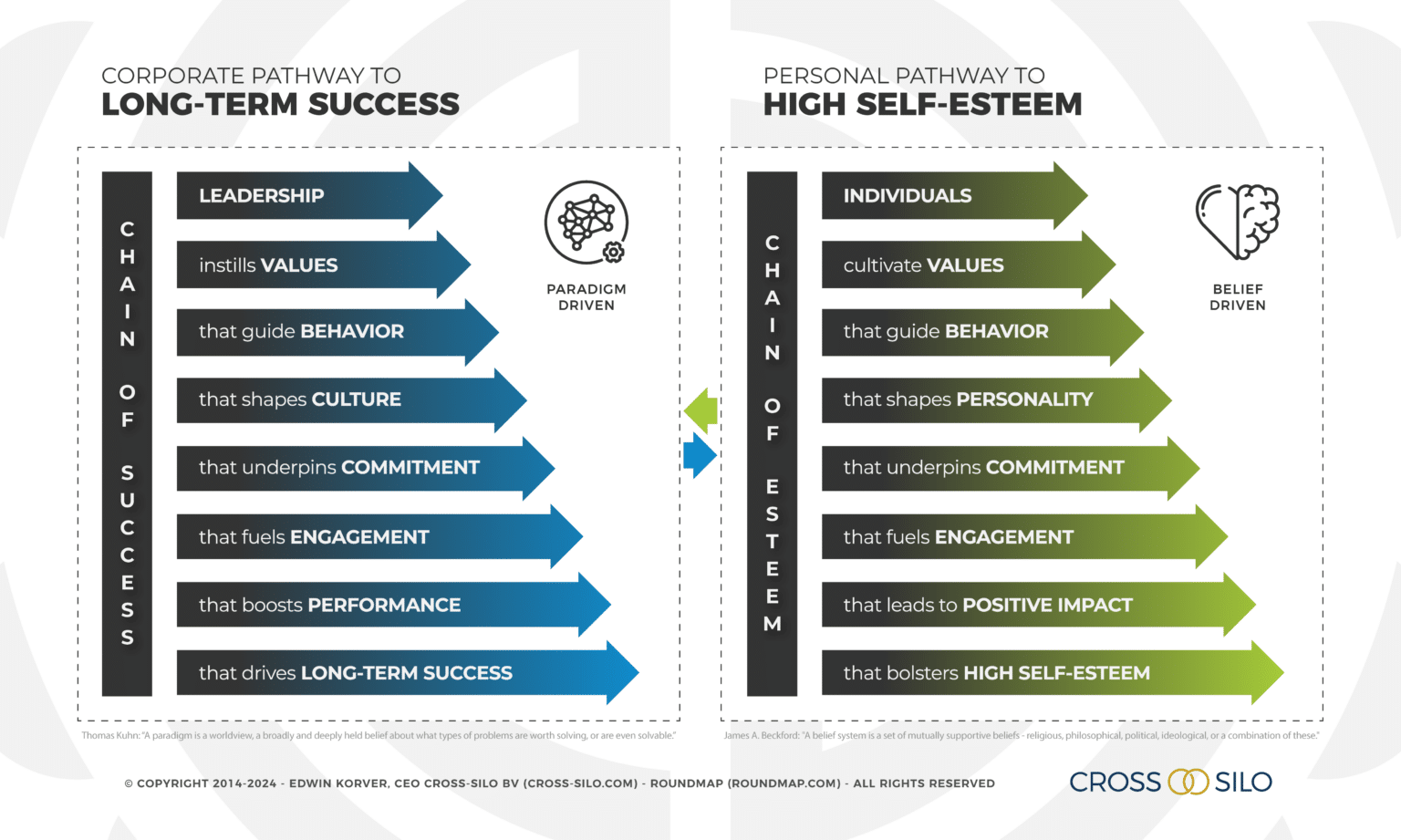After 25 years in leadership roles with organizations such as Southwest Airlines, JetBlue Airways, DoubleTree Hotels, and Juniper Networks, Ann Rhoades is a leading expert on building values-based organizations. Rhoades has proven that when implemented correctly, this kind of corporate culture creates a great work environment for employees and increases all other performance measures.
During a TEDx talk on organizational cultures, Ann explains how leadership drives performance:
The Chain of Success
While I admire her passion and acknowledge her experience, I found it hard to believe that culture drives performance, despite research by Kotter & Heskett, because we know from scientific research in Malaysia that culture drives employee commitment. And from the study by Gallup, that engagement drives performance.
So, I took the liberty to fill in the gaps to create what I choose to call the Chain of Success (to the left):
Chain of Success: Leadership instills values that shape behaviors, which in turn cultivate a culture. This culture fosters commitment, enhances engagement, and boosts performance. Elevated performance paves the way for long-term success, completing a chain of positive organizational transformation.
PS. You may have noticed the Chain of Esteem model to the right. We’ll explain further down the page.
Navigating the Chain of Success: A Step-By-Step Guide to Long-Term Organizational Resilience and Equity
The “Chain of Success” is a conceptual model that aims to illuminate the interconnected factors that lead to long-term organizational triumph. In essence, it serves as a roadmap for cultivating a thriving, resilient, and equitable workplace. Below is a step-by-step textual explanation of the model:
Step 1: Leadership
Importance: The chain starts with effective leadership because every subsequent link depends on it. Good leaders set the tone, establish the values, and create the strategic vision for the organization.
Actionable Insights: Leaders need to lead by example, exercise emotional intelligence, and foster a climate of trust and psychological safety.
Step 2: Values
Importance: Values serve as the organizational compass, guiding employees’ behavior, decisions, and interactions. They are the ethical underpinning of the culture.
Actionable Insights: Make sure values are not just statements on a wall but are incorporated into daily actions and decisions. Regularly revisit and discuss them to keep them alive.
Step 3: Behavior
Importance: Values manifest themselves through the behavior of each individual in the organization. Behavior shapes the daily experience of working within the organization, impacting employee well-being and productivity.
Actionable Insights: Foster positive behaviors through regular training, mentorship, and performance evaluations that are aligned with organizational values.
Step 4: Culture
Importance: Culture is the sum total of behaviors, values, and leadership styles within the organization. It creates a sense of identity and dictates how employees interact with one another and make decisions.
Actionable Insights: Consistently reinforce the culture through internal communications, events, and recognition systems that reward value-aligned behavior.
Step 5: Commitment
Importance: A strong culture begets commitment. When employees are committed, they are more likely to go the extra mile, leading to higher levels of performance and customer satisfaction.
Actionable Insights: Keep employees committed by offering clear paths for career growth, providing meaningful work, and demonstrating that you value their contributions.
Step 6: Engagement
Importance: Engagement is the emotional and psychological investment an employee has in their work and in the success of the organization. It is the penultimate link in the chain that drives performance.
Actionable Insights: Ensure continuous engagement through open dialogue, employee involvement in decision-making processes, and work-life balance.
Step 7: Performance
Importance: Engaged and committed employees deliver high levels of performance, elevating the entire organization and delighting customers.
Actionable Insights: Measure performance using a balanced scorecard approach that includes financial metrics, customer satisfaction, employee engagement, and contributions to societal goals.
Step 8: Long-term Success
Importance: High performance, driven by the preceding links in the chain, culminates in sustainable, long-term success for the organization.
Actionable Insights: Consistently evaluate and fine-tune each element of the Chain of Success to adapt to changing environments, ensuring resilience and long-lasting success.
By meticulously caring for each link in this Chain of Success, organizations can construct a robust framework that stands the test of time, market volatility, and societal changes, ultimately leading to enduring success.
Navigating The Chain of Esteem: A Pathway to High Self-Esteem Through Social Impact
Chain of Esteem: Individuals cultivate values that guide behaviors, shaping personalities. These personalities underpin commitment, fueling engagement, which generates a positive impact. This impact reinforces high self-esteem, creating a virtuous cycle of growth and contribution.
In this esteem model, “impact” is not an abstract concept but a tangible outcome of a life that aligns with meaningful values. It is about creating a ripple effect that starts with individual action and radiates outwards, improving the lives of others. When the impact is the focal point, it enriches our lives. It adds a layer of responsibility, pushing us to be conscientious ValueActors in the larger narrative of community and society.
- Individuals: At the core, we are social beings yearning for connection and significance.
- Cultivate Values: Rooted in our human essence, we cultivate values that become the moral compass directing our actions and decisions.
- Guide Behavior: These values are the engine behind our behavior, the day-to-day actions that reflect who we are and what we believe in.
- Shapes Personality: Over time, these behaviors crystallize into a personality that people identify us by. It is the embodiment of our values, expressed through consistent action.
- Underpins Commitment: Personality fuels commitment and a promise to continue to act in ways that align with our values and positively affect our surroundings.
- Fuels Engagement: A strong commitment naturally propels us into engagement, whether in our relationships, work, or causes we care about. Here we not only participate but strive to go the extra mile.
- Leads to Positive Impact: Engagement evolves into impact when we contribute positively to the lives of others, to society, or to the environment. This is where our actions take on a more significant meaning, transcending our existence.
- Bolsters High Self-Esteem: Finally, our impact is the foundation for our self-esteem. Knowing that we have made a difference provides a sense of worth grounded in our contribution to the collective good.
Closing Thoughts: A Symphony of Aspirations
As we navigate the complexities of the modern business landscape, it becomes increasingly apparent that the goals of organizations and the aspirations of individuals are not mutually exclusive. They are inherently intertwined in a symbiotic relationship that influences each other’s success or failure.
Most corporations tirelessly work toward achieving long-term success—increasing shareholder value, expanding market share, and solidifying brand reputation. Similarly, individuals strive for high self-esteem, which often comes from feeling valued, competent, and impactful in their spheres of influence.
Yet, organizations must recognize that the road to enduring success is paved with the bricks of individual self-esteem and positive social impact. When employees are empowered not just to perform their roles but to excel as individuals contributing positively to society, their increased self-esteem fosters a work environment of commitment, engagement, and, ultimately, heightened performance. This cyclical effect benefits the individual and ripples through the organizational structure, making the pursuit of long-term success not just a target but an achievable reality.
By aligning organizational goals with the personal aspirations of its workforce, companies don’t just chase success; they cultivate it from within. It’s not merely about profits and performance metrics; it’s about people—your most valuable asset.
In this interplay between personal self-esteem and organizational success, it is not just about achieving one at the expense of the other. It’s about creating a confluence where both can thrive—a symphony of aspirations that allows everyone to be proud of being part of the joint endeavor. In this harmonious coexistence, we find a model for businesses that is not only sustainable but also equitable, resonant, and deeply fulfilling.
Author
-
Edwin Korver is a polymath celebrated for his mastery of systems thinking and integral philosophy, particularly in intricate business transformations. His company, CROSS/SILO, embodies his unwavering belief in the interdependence of stakeholders and the pivotal role of value creation in fostering growth, complemented by the power of storytelling to convey that value. Edwin pioneered the RoundMap®, an all-encompassing business framework. He envisions a future where business harmonizes profit with compassion, common sense, and EQuitability, a vision he explores further in his forthcoming book, "Leading from the Whole."
View all posts Creator of RoundMap® | CEO, CROSS-SILO.COM






